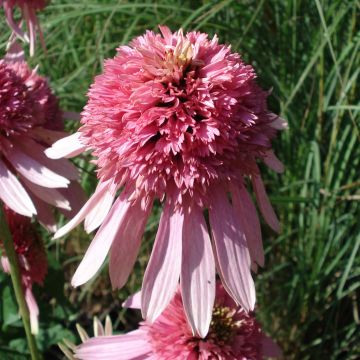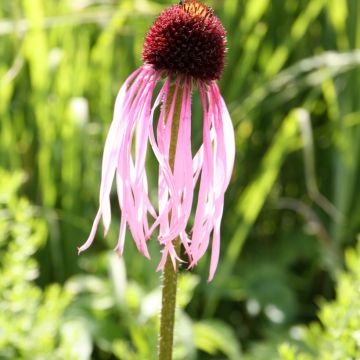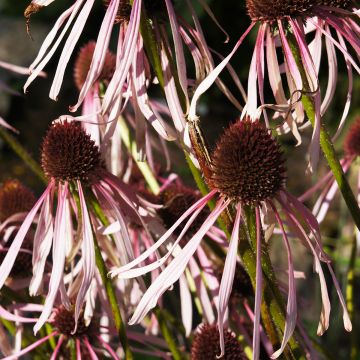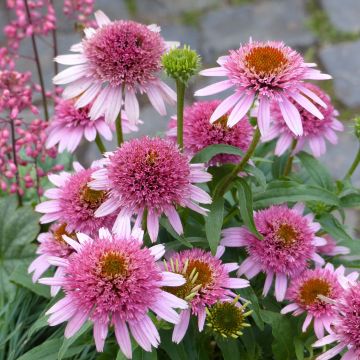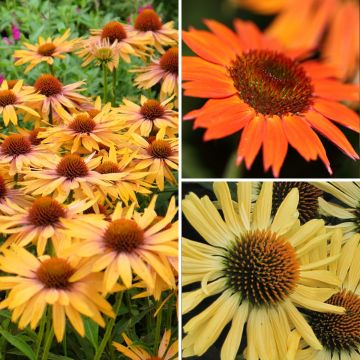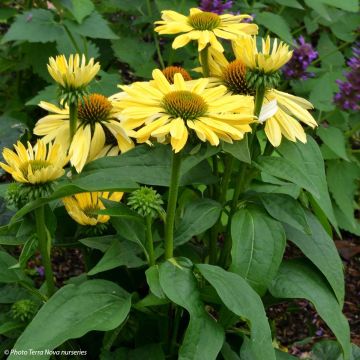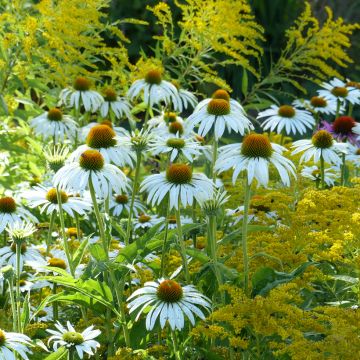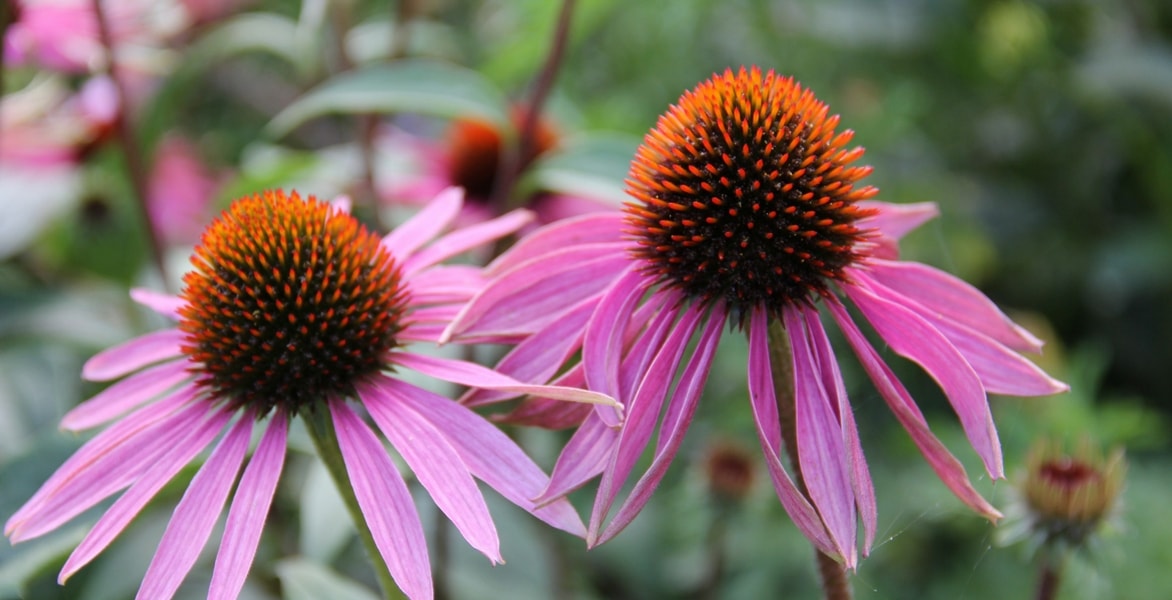
Echinaceas : sowing, growing and care
Contents
Echinacea in a nutshell
- Radiant and colourful, Echinacea is the queen of summer!
- Its unique flowers, resembling large daisies in pink, purple, yellow, orange, white, or even green, bloom all summer long without faltering or interruption.
- Very easy to grow, its only requirement is well-drained soil and a sunny position.
- Incredibly robust, Echinacea adapts to all types of soils.
- It is an essential perennial for contemporary meadow gardens, English mixed borders, and bouquets!
A word from our expert
Echinacea, also known as Purple Coneflower, is a charmer. Renowned for its numerous virtues and benefits in homeopathy and phytotherapy to strengthen the immune system, this medicinal plant truly has everything to please!
Shining a spotlight on summer with this beautiful American that boasts a generous, unconventional flowering!
Terribly alluring, its large flowers with prominent, bristly centres, resembling a simple daisy or a tousled pompom, blossom all summer long in borders, from June to early autumn, without interruption and without bending in the wind.
Essential in a natural garden or in more sophisticated scenes, Echinacea, at times discreet or ardent, adapts to all whims and all forms of creativity. Its solitary yet sunny flowers are great classics of mixed borders, bringing exuberance, character, and whimsy, sometimes even reaching a tasteful eccentricity.
Its inflorescences in heads create colourful fresh bouquets, and its centres will make very graphic dry floral arrangements.
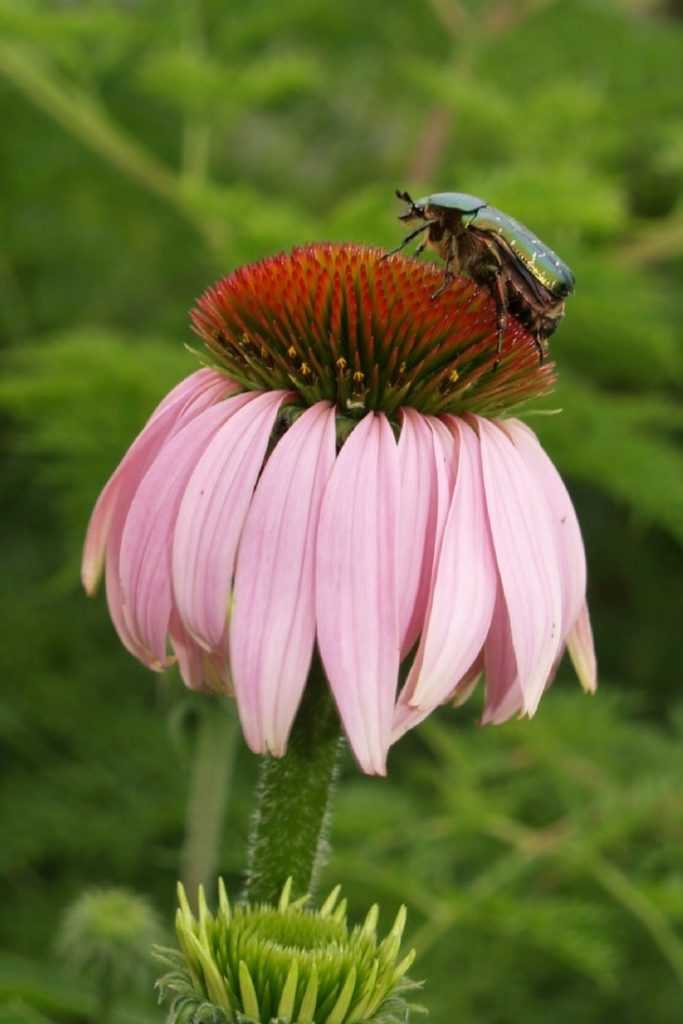
Echinacea purpurea
Each species owes its characteristics to the colour, the appearance of the ligules, and the habit of its flowers, which can be more or less horizontal or pendulous. From the trendiest, Echinacea purpurea, to Echinacea pallida with its finely drooping ligules, through ‘Echinacea paradoxa, the only one in the genus with yellow flowers, or Echinacea angustifolia, the shortest, there is an Echinacea for every gardener! Not to mention the numerous cultivars and new varieties that offer a myriad of pink-violet, cranberry pink, purple, white, orange, yellow, or even green variations!
Very easy to grow, accommodating, this “hedgehog plant” will prove to be grateful and fruitful as long as it is planted in full sun in fertile, deep, loose, cool, and well-drained soil. It is a well-behaved plant that does not bend in the wind and is not afraid of intense heat or occasional drought. It is low-maintenance in terms of water.
Easy to pair, very versatile, it forms beautiful clumps in just a few years with exceptional floribundity, alongside perennials that, like it, require little care and maintenance, grasses, or bulbous plants like dahlias. For an explosive mix of strong tones, it pairs well with Yarrow, Oriental Poppies, daisies, Agastaches, annual Rudbeckia, Coreopsis, Echinops, or Phlox. At the edge of a border, it will shine alongside Shrubby Salvias, Dwarf Gladioli, or Daylilies.
Discover Echinacea, this beautiful, easy-going summer perennial! With its strong presence, it will create scenes that are wild and vibrant in colour!
Botany
Botanical data
- Latin name Echinacea
- Family Asteraceae
- Common name echinacea, purple coneflower, rudbeckia
- Flowering from June to September
- Height from 0.30 m to 1.50 m
- Exposure sun
- Soil type All
- Hardiness -15 °C
Echinacea, also known as Purple coneflower or Rudbeckia, belongs to the Asteraceae family, which includes daisies and asters. Although it comes from a different genus, Echinacea is often associated with its cousin Rudbeckia, with which it shares the appearance of a large daisy with a prominent centre: in Greek, Echinea means “hedgehog” due to the bristly central head. This perennial, with its own character, grows wild in clear wooded areas, large dry plains, rocky hills, and even along roadsides in the United States, particularly in the central and eastern regions of North America. Today, it thrives in all temperate climates. Robust, it can be planted anywhere in France: from its origins in dry prairies, it has retained a great tolerance to sun, competition from other plants, and some resistance to drought. Echinacea is also highly hardy: very resistant to cold, it withstands frost and tolerates temperatures well below -15 °C.

Echinacea purpurea
Nine species of perennials make up the Echinacea genus, but successive hybridizations from which most varieties now originate have produced many interesting cultivars that vary in shape, height, and colour. Some, like the Echinacea purpurea ‘Avalanche’, bear flowers resembling simple daisies, while others, like Echinacea purpurea ‘pink double delight’, resemble large fluffy pom-poms. Each species owes its characteristics to the colour, the length and fineness of the ligules, and the upright or pendulous habit of the flowers. Four species are primarily found in our gardens. The most cultivated and currently the most fashionable in our latitudes is Echinacea purpurea, the type species with purple-pink flowers: it is the most resilient and floriferous. It is also one of the most used in phytotherapy. It boasts over a hundred varieties, including Echinacea purpurea ‘Magnus’, which has exceptionally large and longer-lasting flowers than the type species.
There is also Echinacea pallida, whose flowers with fine ligules are strongly pendulous, and Echinacea paradoxa, which paradoxically is the only species with yellow flowers instead of the usual purple or pink. A large number of cultivars and varieties have resulted from the cross-breeding between Echinacea paradoxa and Echinacea purpurea, such as the magnificent Echinacea purpurea ‘Sunrise’ with pale yellow flowers.
The ‘Echinacea angustifolia, with red-pink flowers, is a sturdy variety; shorter than most other species, it does not exceed 60 cm.
From its thick rootstock emerge in spring clumps of tall, slender yet robust stems, with exceptional hold, resistant to wind. Echinacea displays a very erect tufted habit, more or less branched, easily reaching 1 m in height, with a spread of 60 to 70 cm for the most imposing varieties. Its large, short black rhizome anchors slowly but surely into the soil. Its root is used in homeopathy to combat colds and to boost the immune system. A bit slow to establish, Echinacea needs about two years to properly develop and give its best. If it is happy, it can even become invasive… The type species can notably self-seed. Vigorous, purple coneflower can live for years if it is neither disturbed nor moved. However, cultivars with double flowers have a shorter life cycle; they are less resilient than the type species and may prove biennial.
Once well-rooted, this rhizomatous perennial grows over the years to form dense and highly floriferous clumps.
From June to October, depending on the varieties, the sometimes branched stems bear inflorescences in large solitary heads measuring 2.5 to 12 cm in diameter, with a rare originality.
Conquering, radiant like stars, the flowers of Echinacea are of a solar beauty that cannot be confused. While they evoke the shape of daisies, Rudbeckia, or Heleniums, they possess their own characteristics. They all consist of a dark, hemispherical to slightly flattened heart or cone that can sometimes be very prominent. The central part of the head is formed of pointed and tightly packed florets that are green, brown, or purple, interspersed with yellow or brown scales, giving the heart a bristly pinkish-brown, golden, or orange appearance.
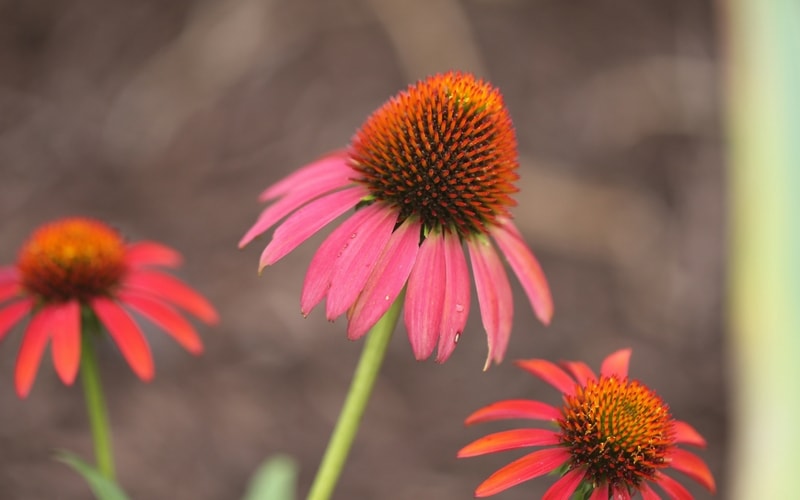
White cultivars have a yellowish-green heart. It is the anatomy of this scaly heart resembling a pine cone that distinguishes Echinacea from Rudbeckia. Some Echinacea varieties, such as ‘Echinacea purpurea ‘Razzmatazz’, are characterized by a very double heart in the shape of a pom-pom, giving the flower a tousled appearance. This spiky pom-pom is surrounded by a collar of long, fine petals or ligules, sometimes rolled, arranged in one or more rows, ranging from violet-pink to cranberry pink, candy pink to pale pink, purple to red, as well as white, orange, yellow, and even apple green! The length, width, and colour of the ligules vary according to the cultivars. It is the ligules that determine the colour of the flower, offering complementary or contrasting hues with the large domed heart. Some varieties, like purple coneflower ‘Green Envy’, have bicoloured pink and green ligules.
It is the more or less inflected habit of these ligulate flowers that makes Echinacea so distinctive. From one species to another, the silky or shiny petals are sometimes so strongly inflected that they resemble a frill, while others spread almost horizontally or are only very slightly pendulous. In Echinacea pallida, the fine pendulous ligules resemble jellyfish tentacles. Some cultivars bear even more astonishing flowers: Echinacea ‘Ferris Wheels’ intrigues with its tubular florets that open and divide at their tips.

Echinacea ‘Green Envy‘, ‘Razzmatazz‘, ‘Tangerine Dream‘ and ‘Ferris Wheels‘
The remarkably generous, colourful, and fragrant flowering lasts throughout the summer: the flowers renew continuously within the bed. They exude a subtle honey scent that is very attractive to pollinators such as bees and butterflies, which intensifies as they bloom. The scent becomes even sweeter and more vanilla-like once the head is pollinated.
Purple coneflower is a highly visited plant! In autumn, the faded flowers produce fruits, the achenes: the heart, now dark brown, releases tiny seeds that can be harvested simply by brushing your finger to dislodge them from the cone. If you have not cut back the stems after flowering, the brown cones suspended from their inflexible stems will prolong the decorative effect during the dreary season, and the seeds left in place will provide a feast for certain bird species such as finches, goldfinches, and tits at the beginning of winter.
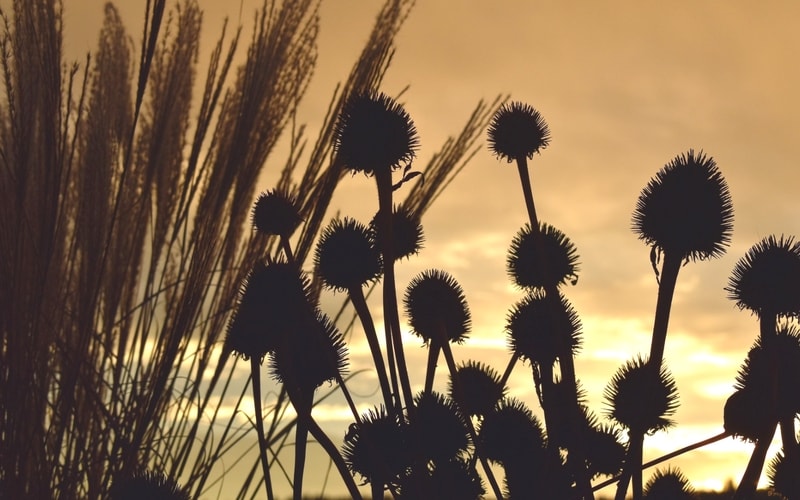
Leave your echinaceas in place at the end of summer to enjoy their fabulous winter display
Echinaceas are highly valued in floral art; the large, vibrant heads make for very pretty cut flowers, both fresh and dried. Fresh flowers, which last long in a vase, create beautiful sunny, sparkling, and flamboyant summer bouquets. Its well-ripened spiky cones are particularly graphic in dry bouquets.
Deciduous, the foliage of Echinacea resembles that of daisies and rudbeckias. Its interest lies mainly in its abundance. The straight stems bear narrow, dark green, oval to lanceolate leaves, slightly dentate, smooth or most often bristly with rough hairs. More numerous at the base, they are alternate and sparse towards the top of the stems. The basal leaves, which are shorter than those on the stems, are not very decorative. Once dried, the leaves emit a vanilla scent.
Echinacea is a good-natured plant, uncomplicated, docile, and fertile as long as it is planted in full sun. While it adapts to all soils, it will thrive to become gigantic in fertile, deep, loose, fresh, and well-drained soil. It is a robust plant with good hold that fears neither wind, nor occasionally intense heat, humidity, or drought.
Versatile, it flowers in naturalistic beds, enlivens borders, and enchants English mixed borders. Some reasonably sized varieties, like Echinacea ‘Southern Belle’, are also suitable for pot cultivation. As it accepts growing near roots without them hindering its development, it can be planted close to shrubs, provided they do not deprive it of sunlight! Echinacea is very easy to pair with other low-maintenance perennials to create scenes with a wild and colourful appearance.
Once well-rooted in suitable soil, it requires no special care and offers excellent resistance to pests and diseases.
Echinacea (notably the species pallida, angustifolia, and purpurea) is a medicinal plant widely used in homeopathy and phytotherapy to treat wounds, skin rashes, respiratory infections, and to stimulate the immune system.
Read also
How to plant Echinaceas?Species and varieties
Colours, heights, and shapes abound in an infinite variety, and many cultivars are now available. This family consists of numerous varieties with double and single flowers. The choice becomes more complex between pink-flowered, white-flowered, red, yellow, orange, or even green Echinaceas! It is the characteristic of the habit of the ligulate flowers, with a simple or very double collar, evoking a wise daisy or a tousled peony, and the colour of the ligules, pure white, purple, violet-pink, old rose, candy pink, yellow, orange, or green that primarily guide the gardener. Cultivars with quite spectacular double flowers like Echinacea purpurea ‘Razzmatazz’ are less robust than single-flowered Echinaceas.
There are four species commonly cultivated in our gardens: the type species, Echinacea purpurea, is certainly the most common because it is also the most robust. It has over a hundred cultivars. There is also Echinacea pallida, whose flowers have fine ligules that are strongly trailing and Echinacea paradoxa, which has the paradox of being the only one in the genus with yellow flowers instead of the usual purple or pink. A large number of cultivars and varieties are derived from the cross-breeding between Echinacea paradoxa and Echinacea purpurea. Echinacea angustifolia is a stout variety that does not exceed 60 cm.
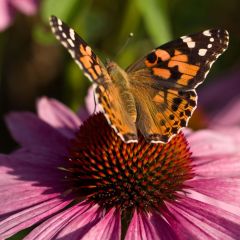
Echinacea purpurea - Purple Coneflower
- Flowering time August to November
- Height at maturity 80 cm
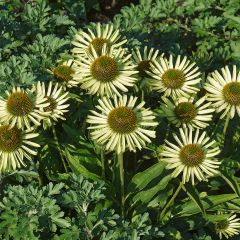
Echinacea purpurea Avalanche - Purple Coneflower
- Flowering time August to October
- Height at maturity 50 cm
/]
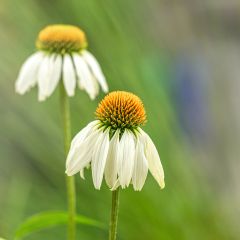
Echinacea purpurea Alba - Purple Coneflower
- Flowering time August to October
- Height at maturity 80 cm
/]
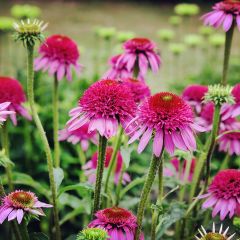
Echinacea purpurea Catharina - Purple Coneflower
- Flowering time August to October
- Height at maturity 80 cm
/]
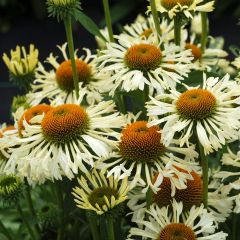
Echinacea purpurea Ferris Wheel - Purple Coneflower
- Flowering time August to October
- Height at maturity 60 cm
/]
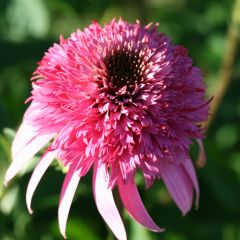
Echinacea purpurea Razzmatazz - Purple Coneflower
- Flowering time August to October
- Height at maturity 1 m
/]

Echinacea purpurea Magnus - Purple Coneflower
- Flowering time August to October
- Height at maturity 1 m
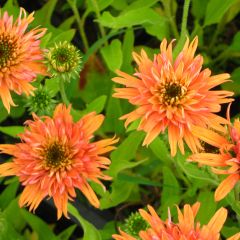
Echinacea purpurea Colourburst Orange - Purple Coneflower
- Flowering time August to October
- Height at maturity 50 cm
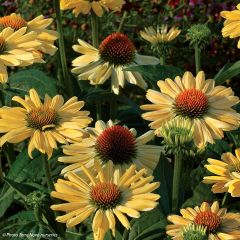
Echinacea purpurea Aloha - Purple Coneflower
- Flowering time August to October
- Height at maturity 90 cm
/]
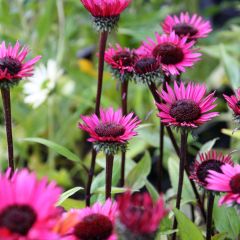
Echinacea purpurea Fatal Attraction - Purple Coneflower
- Flowering time August to October
- Height at maturity 70 cm
/]
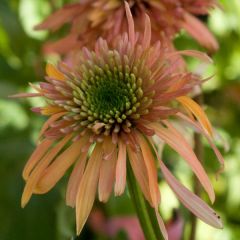
Echinacea purpurea Cranberry Cupcake - Purple Coneflower
- Flowering time August to October
- Height at maturity 35 cm
Other interesting varieties

Echinacea purpurea Green Jewel - Purple Coneflower
- Flowering time July to October
- Height at maturity 60 cm
/]
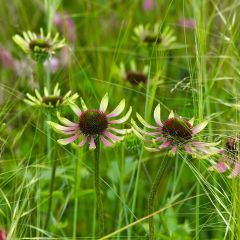
Echinacea purpurea Green Envy - Purple Coneflower
- Flowering time August to October
- Height at maturity 50 cm
/]
Discover other Echinacea - Coneflower
View all →Available in 1 sizes
Available in 3 sizes
Available in 3 sizes
Available in 2 sizes
Available in 1 sizes
Available in 2 sizes
Available in 3 sizes
Available in 0 sizes
Available in 1 sizes
Planting
When to plant Echinacea?
Echinacea is best planted in spring from March to April or in autumn from September to October, avoiding periods of frost and drought.
Where to plant Echinacea?
Very easy to grow, Echinacea thrives almost everywhere in France, and it even adapts to coastal areas. In cold and humid regions, it requires a mulch. With good hardiness (well below -15°C), it withstands frost but does not cope well with extreme cold. However, it can tolerate heatwaves.
Once well-rooted in a suitable location, it flourishes year after year, becoming increasingly floriferous. Just be sure not to disturb it: let its roots spread quietly as it dislikes being transplanted. However, cultivars with double flowers have a shorter lifespan, are less resilient than the typical species, and may turn out to be biennial.
If it is happy, it can even become invasive… The typical species, Echinacea Purpurea, can notably self-seed spontaneously.
Choosing the right location for planting is therefore crucial: ensure it has enough space!
While it can tolerate light shade, it is a sun-loving plant that requires a sunny exposure. Whether in a border or even on a gentle slope, it will adapt! Some low varieties like Echinacea ‘Avalanche’ or Angustifolia are very comfortable for pot cultivation.
It accepts all types of soil, neutral, not too dry to moist, but it will reach its full potential in deep, fertile soil. It simply does not like to have its feet in water: winter flooding is fatal to it. It needs very well-drained soil.
Incredibly robust, it is hardly afraid of anything: neither diseases, nor bad weather, nor frost, nor strong winds, against which its stems do not bend, nor drought, nor the intense heat it can occasionally endure.
Versatile, it fits into all settings, thriving as a middle plant, at the back of a border, or in a flowerbed. Against a backdrop of climbing roses, clematis, and grasses, pair it with other perennials in vibrant colours that require little care and maintenance such as Achilleas, Dahlias, Asters, Oriental Poppies, Delphiniums, Agastaches, Rudbeckia, Lupins, or Phloxes.
How to plant?
Somewhat slow to establish, once well settled after two years, it offers a beautiful longevity with an increasingly generous flowering. A planting that matches its floribundity is therefore necessary. It prefers soil that remains moist during summer, especially in the first few years (as it matures, it will tolerate drought better) and well-drained. It fears waterlogged soils in winter. The soil should be deep and loose to best develop its root system. It struggles a bit with the close presence of other plants: give it some space!
It must be rich in organic matter to allow the plant to bloom well. In poor soils, it will never be lush.
- Loosen the soil, work the earth well.
- Plant it in a mixture of potting soil, with a good dose of well-decomposed compost and garden soil.
- Count 5-7 buckets per m², given the strong growth of this perennial, this is sufficient to create a beautiful effect.
- Space the plants 25 to 30 cm apart when planting.
- Once the young plants are established, they should not be disturbed. They will only start to thicken and bloom properly in the second year.
- Mulch in spring to keep the soil cool at its base with a pine bark mulch, especially during summer, as this guarantees prolonged flowering.
- In spring, protect its young shoots from slugs and snails; if necessary, use fern juice to combat their attacks.
- Echinacea loves fertile soils: feed it regularly with fertiliser to promote its flourishing.

From March, Echinaceas awaken and the first leaves appear: it is wise to protect them from the appetite of slugs!
Pot cultivation
- Choose varieties with a compact growth habit.
- Mix potting soil with good garden soil.
- Water regularly in summer, but without excess.
To learn everything about planting Echinaceas, discover our advice sheets: “How to plant Echinaceas” and 6 secrets to successfully grow Echinaceas
Care
Highly resistant to diseases, once well established, Echinacea requires little care and proves to be a trouble-free perennial with robust health. Provided that the soil remains perfectly drained, sufficiently nourishing, and cool in summer.
- Remove the flowers as they fade to encourage the appearance of new blooms.
- Cut back the remaining stems to 15 cm above the soil in October to prevent invasive self-seeding (make a dried bouquet) or in early spring if you have left a few withered stems standing: very graphic to enliven the border in winter.
- Mulch in May to ensure the base remains sufficiently cool in summer.
- Add compost in autumn or spring.
- Water in case of prolonged drought: it tolerates periods of intense heat very well.
- As the plant ages, it may be susceptible to powdery mildew and more sensitive to aphid attacks.
- It may also exhibit a sparser flowering: after 5 years, in spring or autumn, divide the largest clumps. Only resort to this division if the plant shows signs of fatigue, as Echinacea does not like to be disturbed.
Possible diseases
Little sensitive to diseases, it has only a few rare enemies: gastropods at the start of the growing season and powdery mildew when it begins to reach ripeness.
Propagation
Dividing clumps is possible but extremely delicate; the risk of killing the plant is significant as it does not appreciate having its fragile rootstock disturbed. Root cuttings can be taken, but they are equally risky. As Echinacea seeds very easily, sowing remains the least tedious and, above all, the least risky operation.
Sowing Echinaceas
This is the simplest method: this perennial is very easy to grow from seeds. Sowing is done in spring with well-ripened seeds harvested in autumn as soon as they turn brown, before they fall, or with seeds purchased in packets.
- Keep them cold for a few weeks before sowing to encourage germination.
- Sow the seeds in spring in a mix of potting soil and garden soil, barely covering them, using vermiculite, for example.
- Place the tray under a warm frame at 15-20°C.
- Water regularly but do not saturate the substrate.
- Expect germination in 2 to 4 weeks.
- When the seedlings have two true leaves, transplant them into individual buckets.
- Plant them in the ground in autumn or the following spring when the seedlings have hardened off well.
- The plants will flower from the second year.
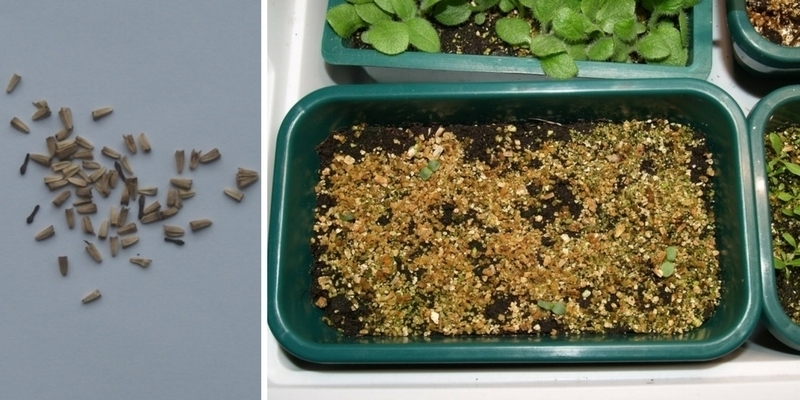
Echinacea seeds and sowing: germination occurred within a week, using a heated propagator.
→ Learn more in our tutorial: How to sow Echinaceas?
Association
Versatile, Echinacea is very easy to combine; it is even inspiring for creating a garden of naturalist inspiration, or a mixed-border in the spirit of cottage gardens with other upright perennials that require little care and maintenance. However, with its long and graceful stems, it also brings elegance and originality to more sophisticated spaces.
Some reasonably sized varieties, such as Echinacea ‘Southern Belle’, are also suitable for pot cultivation. Echinacea is very easy to combine with other perennials that require little care and maintenance to create scenes with a wild appearance and vibrant colours.
Planted in numbers rather than alone, it gives substance to a border with its very strong presence, either by providing contrast or in a degraded or monochrome version of purple, pink, yellow, or white. We love to associate its intense colours with complementary colours in a joyful and rebellious spirit, with combinations of crimson/blue, orange/peach, white/purple. For an explosive mix of strong tones, it pairs well with Achilleas, Oriental Poppies, Daisies, Agastaches, Rudbeckia, Coreopsis, Echinops, or Phlox. At the edge of a border, it will shine alongside Shrubby Salvias, Dwarf Gladioli, or Daylilies.
By placing it near shrubs with flamboyant foliage (such as Euonymus) and late-flowering perennials (Asters, Dahlias, Snapdragons, Heleniums, Autumn Stonecrops. ..) whose foliage develops during the summer, it heralds the fires of autumn.
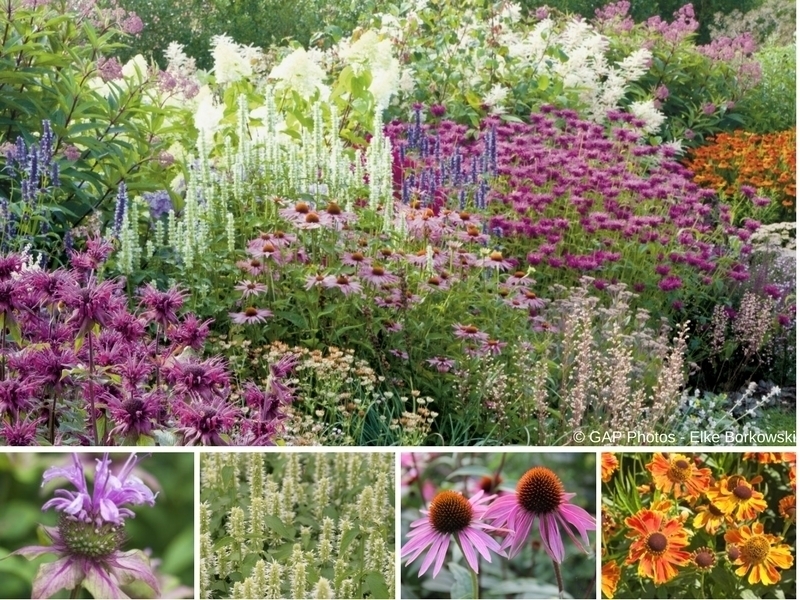
Another example of association for echinacea, with Monarda fistulosa menthifolia, Agastache ‘Alabaster’, and Helenium ‘Waltraut’
To calm the scene, we use or abuse the grey or blue foliage of Artemisias or Santolines. Grasses and light-statured perennials like Gaura or Baby’s Breath will bring softness and movement in contrast to the somewhat stiff habit of Echinacea.
It is also the perfect companion for late-flowering climbing roses, at the feet of which they create exquisite late summer scenes, ensuring an exuberant foreground.
Need a little extra inspiration? Check out our advice sheet: “Echinacea or Purple Rudbeckia: 7 beautiful pairing ideas”
Useful resources
- Discover our extraordinary range of Echinaceas: all varieties are available with us!
- Follow Ingrid’s advice on our blog to create a beautiful perennial bed
- Because sowing Echinaceas is simple: make your choice from our seeds!
- Sowing Echinaceas? A great option to flower your garden at a lower cost!
- Discover our buying guide Choosing an Echinacea
- Also, check out our advice sheet on slow-to-establish plants
- Everything you need to know about planting Echinaceas in our advice sheet: 6 secrets to successfully grow Echinaceas
- Echinaceas in all colours: 5 pink Echinaceas for a blooming garden in summer; 5 orange-flowered Echinaceas to discover; 5 yellow Echinaceas
Frequently asked questions
-
It is said that dividing Echinaceas is not recommended; is this true?
Dividing clumps is possible but extremely delicate; the risk of killing the plant is significant as it does not appreciate having its fragile rootstock disturbed. This is why we indeed advise against it. Sowing remains the least tedious and, above all, the least risky operation. You can potentially collect plants from spontaneous sowing or harvest seeds from the year. It is possible that as the plant ages, it becomes more susceptible to powdery mildew and more sensitive to aphid attacks, and may exhibit a more sparse flowering: after 5 years, but not before, in autumn, divide the most substantial stumps. Only resort to this division if the plant shows signs of fatigue, as Echinacea does not like to be disturbed.
- Subscribe!
- Contents































